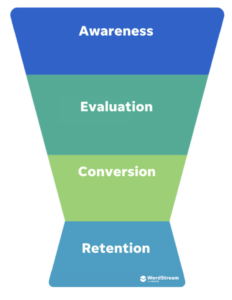How to start a content library using a non-funnel approach
Not sure what to write about next? It happens to the best of us.
You rack your brain and write — but the only problem is that you’ve written the blog post for yourself.
When do you stop to think about what your clients might find interesting?
Or how will you stay relevant among competitors? (Trust us, you have some.)
If you’re not sure how to get out of your head to make content for your target audience, this post is for you!
Footloose and funnel-free
 In previous issues, we’ve talked about the content funnel and ways to generate ideas that speak to clients at different stages of the buying journey:
In previous issues, we’ve talked about the content funnel and ways to generate ideas that speak to clients at different stages of the buying journey:
• Awareness – At this stage prospects have realized they have a problem and you just might have the answer
• Evaluation – At this stage prospects realize your solution seems legit but they want to know more about you
• Conversion – If you get to this stage, you’ve got a customer and can deliver a different
• Retention – Here is an opportunity to maximize the long-term ROI of repeat customers
If your goal is to have a diverse and balanced content library, then the funnel is a universal tactic to achieve this.
Maybe you’re thinking: “But my company has been publishing a weekly current events blog, and that’s all I can handle right now!”
That’s great! Don’t stop. This is just one strategy to get a subscriber base going and to get people through the door to showcase your company, product, and/or service.
But let’s dig a little deeper. Because, at some point, you may wish to diversify your brand and content marketing.
5 easy steps to content creation
Even if the content funnel isn’t your cup of tea, you approach content ideation from another angle.
So let’s try a less formal approach.
Start by noting a few top-line, abstract content categories:
1. You want to educate and teach people something. From the basics to the technical stuff behind your industry.
2. But you also want to sell a little bit. You want to show how awesome your solution is at tackling problems x, y, and z, and why people should choose you.
3. You want to share your unique views on the trends in your industry. That’s why people come to you, right? Because you’re a thought leader and you offer something that your customers don’t have, or that can help them do something easier or better.
4. You want to tell people about how your company came about and highlight your team members.
5. And finally, wouldn’t it be great to have something somewhere dedicated to answering the most frequently asked questions among your business prospects and clients?
Hey, these are beginning to sound like real grown-up content categories! We’re really getting somewhere.
Now, let’s do some refining.
Narrow down your list to look something like:
Educational resources
Benefits and features
Industry trends, corporate perspectives
Company culture
FAQs
A diverse content library keeps people engaged by covering multiple tactics, strategies, and categories.
So from here, we can jot down some sub-topics that branch out from each of these categories.
For example, let’s put ourselves in the shoes of a retail bank. Diving deeper into the first three categories may look like this:
Educational resources:
What is my savings APR?
Should I pay off debt or invest?
Benefits and features:
Mobile deposits
Online consults
Industry trends:
Is my cash safe in times of crisis?
How is my bank helping me or other businesses right now?
And so on.
You may not know it, but this alternative approach is creating content that could fit very nicely into a funnel strategy.
But we won’t tell anybody!